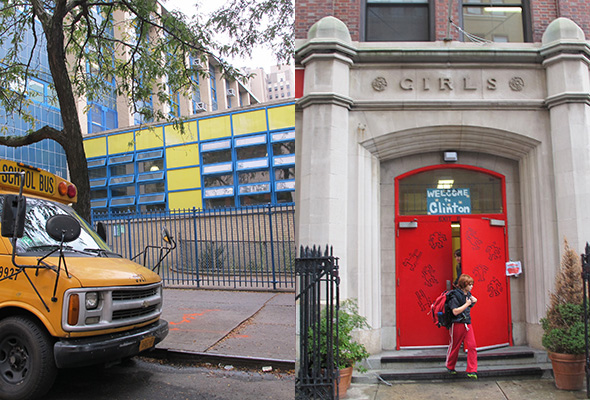
The New York City Department of Education has released its sixth round of progress reports, which grade public elementary and middle schools on an “A” to “F” scale based heavily on students’ test performance. Parents at two Midtown West schools had mixed feelings about the grade affixed to their children’s schools.
Public School 111 on West 53rd Street, between Ninth and Tenth avenues, received its second consecutive “C.” If the school gets another “C” next year it will be flagged for possible closure by the city. The Clinton School for Writers and Artists on West 33rd Street, also between Ninth and Tenth avenues, got an “A,” up from a “B” last year.
In the midst of a national debate on the quality of public school teachers, emphasized most recently by the Chicago teachers strike, most Midtown West parents agreed that teacher quality is a key ingredient for success.
Patricia O’Donnell, who has three children at Public School III, in first, third, and eighth grades, said the school deserved its “C” grade. She has been active in the PTA since her first child started Kindergarten at the school in 2004, and has had a contentious relationship with the staff on issues ranging from the misappropriations of PTA funds to allegations of a physically abusive teacher.
“We have teachers that are really good and teachers who are really, really bad,” she said. “Even after all these years, we still have issues with getting bad teachers out.”
At Clinton, when asked why the school merits an “A” grade, parents pointed to the school’s staff. Daphne Seligmann, mother of a seventh-grader, gushed about the sterling credentials of the staff.
“Some of the teachers even have PhDs,” she said.
Tim Skehan, the father of a sixth-grader who started at Clinton in September, is already impressed with the school’s team.
“They have created this warm, loosey-goosey environment where children can learn,” he said. “ [My daughter] even likes her science teacher which surprises me since she identifies as an artist, and has never really liked science.”
Several factors are considered in calculating a school’s grade. However, the largest portion, 80 percent, is based on how students perform on state administrated standardized tests. Student grades represent another five percent of a school’s grade. Parent, student and teacher surveys, as well as the school’s attendance rate, account for the remaining 15 percent.
Of the 1,193 elementary and middle schools graded, 304 schools got an “A”; 421 received a “B”; 365 a “C”; 80 got a “D”; and 23 an “F.”
But not all parents agreed with the city’s appraisal of their child’s school. Johnny Tamayo, an immigrant father living in Hell’s Kitchen, has a fifth-grader at Public School 111. He had nothing but good things to say about the school. “I would give the school an ‘A,’” he said. “[My son] came to this country just three years ago and they taught him English in less than two [years].”
Parents at both Clinton and Public School 111 also noted the important role that extracurricular activities play in educating children. “Art develops the brain,” said Seligmann, “All the art [at Clinton] helps students learn math, science, and English.”
Parents at Public School 111 complained of a less robust extracurricular offering at their children’s school. “When we first got [to Public School 111], we had no gym teacher and no music teacher,” said O’Donnell. “We have come a long way, we have music and gym now.”
But O’Donnell lamented that to expand the school’s resources, the school needs more money. “The principal is always looking to the PTA to raise money,” she said. “We are not a $20,000 a year PTA, we are lucky to raise a couple of thousand.”
“We have tried book fairs and bake sales but it doesn’t work,” she said. “We have a lot of lower income families and a lot of new immigrant families. Parents just don’t have the money to invest in the school.”
The city’s data underscores the parental resources gap among schools in the neighborhood. The city estimates that between 61 and 70 percent of families at Public School 111 receive public assistance. At Clinton, that number is between 21 and 30 percent.
O’Donnell has tried to get her children out of Public School 111. “My husband and I applied to [Public School 212],” she said. “We didn’t get in; maybe we don’t make enough money to get into that school.”
Like Clinton, students must be accepted into Public School 212, a Hell’s Kitchen school that received a “B,” though only families in the district may apply. Both schools are located in District 2, one of 31 geographical districts in the city,which includes all of Manhattan below 59th Street, with the exception of the East Village and Lower East Side, as well as the Upper East Side below East 97th Street.
These District 2 application-required schools, unlike zoned schools like Public School 111, pull students from some of the city’s toniest neighborhoods including the Upper East Side, Tribeca and the West Village.
Despite being stuck in a school that the city deems to be a “C” school, O’Donnell likes the city’s progress reports. “The grades are fair,” she said. “They help me when I’m trying to get the bad teachers out.”